Top Of The World: In 1980, Jeff Glasbrenner lost his leg. In 2016, he climbed Mount Everest

The Khumbu Icefall is a terrible beauty, a looming jumble of frozen minarets and seracs guarding the southwestern slopes of Mount Everest. Navigating it, says climber Lisa Thompson, feels not so much like walking on the mountain as it does walking through it.
“There is the visual of these towering, teetering ice blocks,” she says, “but also the audio of ice cracking around and beneath you, reminding you that it’s moving, it’s alive. It could swallow you whole at any second.”
Early in the morning on April 18, 2014, a massive serac released, resulting in an avalanche that killed 16 Nepalese guides. The Everest climbing season was canceled, as it was again a year later, following a 7.8 earthquake that killed 9,000 people in Nepal and triggered another avalanche that slammed into the mountain’s base camp, taking 20 lives. Even by the unforgiving standards of Everest, on which at least 280 people have died since the peak was first summited in 1953, it was a ghastly two-year stretch.
Climber dies in accident while preparing to climb Mount Everest without oxygen
Among the teams returning to the mountain in 2016 was a group led by Garrett Madison, a veteran guide based in Seattle who was assisted by Brent Bishop. Bishop—along with Thompson and Jeff Glasbrenner—are the central characters in Capturing Everest, a joint production between SI and Endemol Shine Beyond USA. It’s the first virtual reality documentary of an expedition up the world’s tallest mountain.
Thompson, 44, was an ambitious, successful executive and recreational climber whose battle with breast cancer forced her to reflect on how little time we are allotted on earth. In March 2016 she quit her job, sold her house and signed up to climb Everest. The sage, serene Bishop qualifies, in this country, as mountaineering royalty: His father, the late Barry Bishop, was a member of the first American team to stand atop Everest, in 1963. Having twice summited that peak before last year’s expedition, Bishop, 50, was intimately familiar with the dangers of the Khumbu Icefall, which entails, he says, "2 1⁄2 miles [weaving] through chunks of ice as big as a small office building. . . . It’s terrifying.”
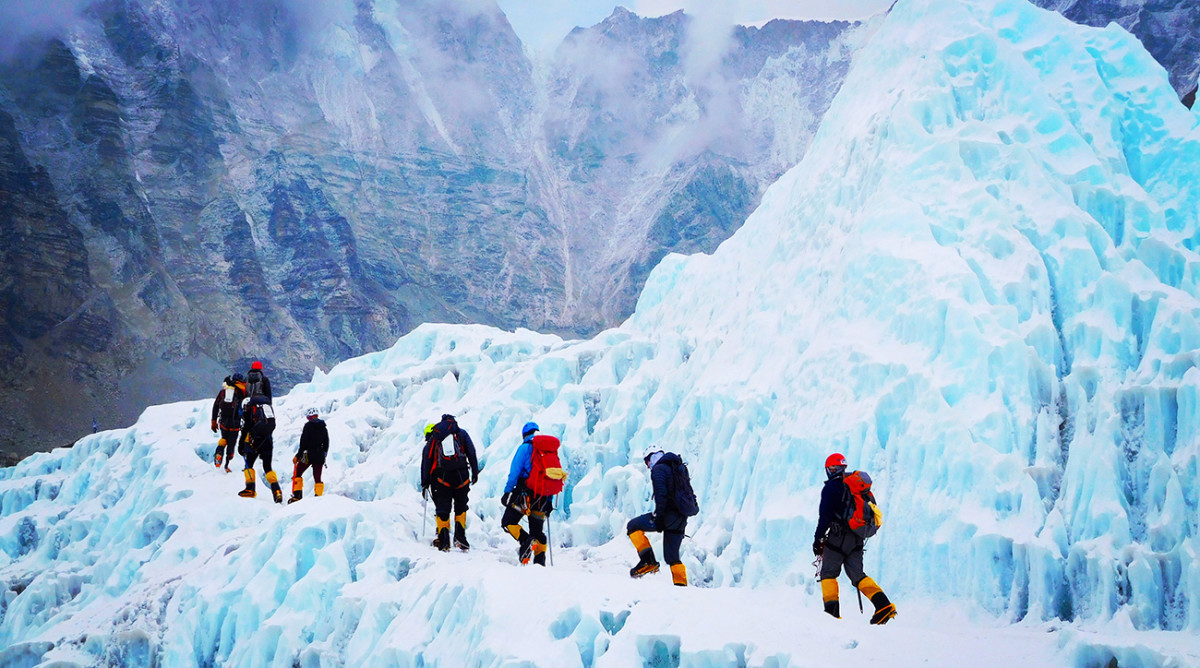
The experience was even more daunting for Glasbrenner, 44, especially as he navigated the ladders serving as flimsy bridges over the Icefall’s many crevasses. Missing his right leg below the knee, Glasbrenner’s quest was to become the first American amputee to scale Everest. His $50,000 climbing prosthetic is cutting edge, but it can’t provide feeling in his nonexistent ankle, foot and toes. “They tell you not to look down,” says Glasbrenner, who had to look down to make sure the cramponed foot of his “Everest leg” was properly placed on the rungs of the ladder.
Glasbrenner and his mates endured six passages of the Khumbu Icefall—all necessary parts of becoming acclimated to the altitude. “A lot of people assume you just go to base camp, then climb up to the top and get out your selfie stick,” says Glasbrenner. “It’s a little more involved than that.”
To wit: After a nine-day trek from the tiny airstrip at Lukla to the “throne room of the mountain gods,” as Bishop refers to Everest base camp, climbers commence a series of “rotations” designed to boost their production of oxygen-carrying red blood cells. Only after several weeks of this training are they considered acclimated and ready for the final push to Camp 4—aka the Death Zone—at 26,085 feet, and the summit beyond.
"On Everest, small problems turn into big problems. As they say on the mountain, 'lose a glove, lose a hand.'"
All who would presume to stand at the top of the world—29,029 feet, close to the cruising altitude of most commercial flights—must endure the full spectrum of suffering, physical and mental. On his first night in Camp 1, just shy of 20,000 feet, Glasbrenner woke up oxygen-starved and, for a scary minute or so, was struggling to breathe (a temporary condition called Cheyne-Stokes respiration). As the expedition wore on, he coped with the additional anxiety of watching his weight drop. He lost 20 pounds from his 6' 2", 170-pound frame—nearly half of that in the final week, as the team fidgeted through a five-day holding pattern at Camp 2 (21,000 feet), waiting for 200-mph winds at the summit to die down.
As Glasbrenner became leaner, so did his stump, which made the fit of his prosthesis less snug. Thankfully, he’d anticipated this issue and developed a high-tech solution for it: “I just kept adding socks. Lots of socks.”
“On Everest,” he says, “small problems turn into big problems. As they say on the mountain, ‘Lose a glove, lose a hand.’ I had to be highly attentive to my leg.” A sore or abrasion on his stump, he noted, “could have meant game over.”
The weather improved; a window opened. At 10 p.m. on May 17, the group left Camp 4, aiming to summit shortly after sunrise. Glasbrenner has never spent a longer night. “It’s dark, you’re on a fixed line. You take a step, lock out your back leg, take three breaths. Repeat. We did that for 10 1⁄2 hours.”
Glasbrenner’s resting heart rate is 43. On that grueling push to the summit, it was between 160 and 180 beats per minute. In the hours before sunrise, he recalls, “I was thinking, Wow, I don’t know if I can do this.”
Breaking dawn revealed the serrated peaks of the surrounding Hima-layas, a tableau so stunning, he says, “that I can’t begin to describe it.” Sitting at his kitchen table in Golden, Colo., 11 months later, he pulls up a shirtsleeve to show his goose bumps.
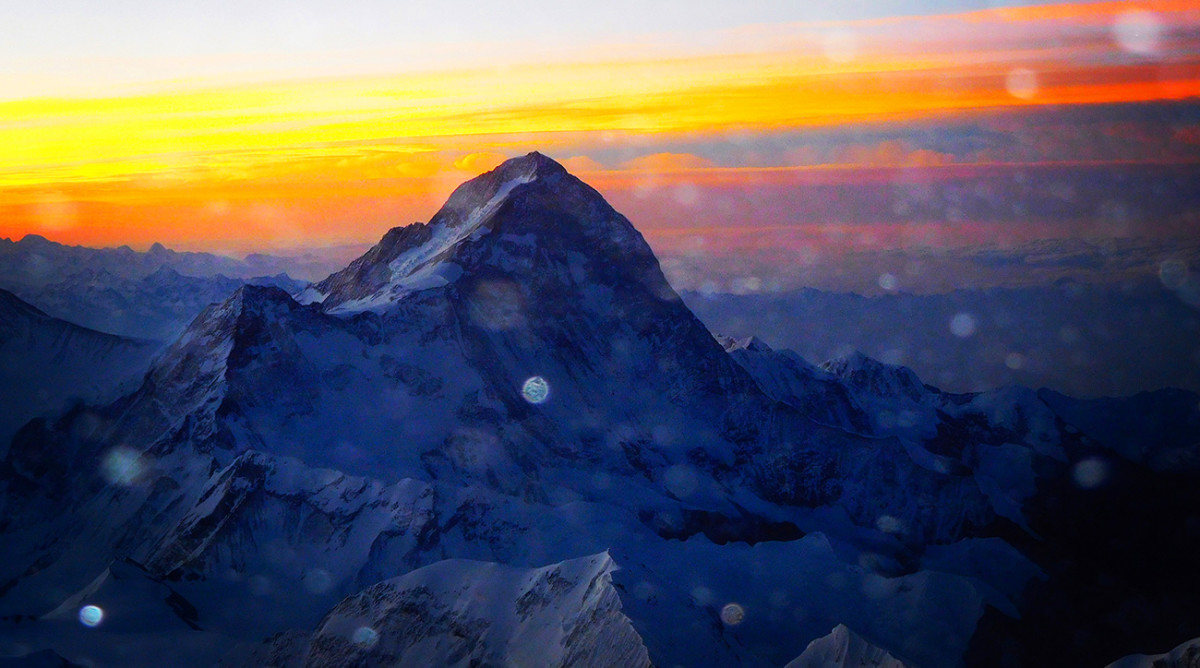
Attitude adjusted, he pushed on. The view that morning provided instant perspective, a reminder of how far he’d climbed. Decades earlier Glasbrenner had passed through a different kind of death zone.
"I mean, you think doctors know best. It turns out they don't know everything."
When the blade of his John Deere 60 tractor made a harsh, scraping sound, Jeffrey Glasbrenner cut the power and looked at his eldest son. The two of them were cutting hay on the family’s cattle farm in Boscobel, Wis. As he had many times before, towheaded, wiry, eight-year-old Jeff Jr. jumped from his safe spot on the tractor, removed the offending rock, and pulled out any excess alfalfa wrapped around the blade. Normally, his dad would turn on the power once his son was back in his safe spot. On this July morning in 1980 he pushed the PTO (power take-off) button a moment too early. Jeff’s pant leg caught in the spinning shaft, pulling his right leg into the machinery. The next thing Jeff knew, he was lying in the field looking down at his truncated, bloody limb. “Ten feet to my right,” says Jeff, “I saw my shoe with my foot still in it.”
Jeff Sr., who died in 2010, carried guilt from that day to his grave. The older Jeff Jr. got, says his sister Jenelle, “the more he realized that our dad saved his life” by using his hands as a tourniquet—squeezing the leg to stanch the flow of blood. Had he not done so, doctors told the family, Jeff would have died before arriving at the local hospital. From there he was driven by ambulance 70 miles to a larger hospital in Madison.
Glasbrenner spent 47 days there, undergoing 14 surgeries. He contracted gangrene. Twice, his heart stopped and doctors had to bring him back. Those days were long and stressful, his mother, Sandy, wrote in a letter to him five years ago, “but we still had you!” Doctors removed skin from his back to graft onto his stump, then skin from his backside to replace the skin on his back. This took place in the burn unit, where many of the patients “had so much pain that they would scream, and then you would scream,” wrote Sandy, “and I would just cry for you.”
In the room next to Jeff’s was a boy from Green Bay, dying of cancer. That boy’s mother shared some valuable advice with Sandy. Sometimes, she warned, the worst enemy of a special-needs child is that child’s mother. Sandy could raise her son to be independent, “or raise him to need everyone around him for the rest of his life.”
The day Jeff left the hospital, a doctor handed him a piece of paper. On it was a list of activities he must never attempt: swimming, riding a bike, playing sports. “They were afraid I would hurt myself or hurt other people,” he says. “And the really bad thing is, I believed them. I mean, you think doctors know best.
“It turns out they don’t know everything.”
For many years, he obeyed. He worked hard to keep a low profile at school—to avoid drawing the attention of bullies who taunted him or impersonated his uneven gait. “We grew up in a small town,” says Jenelle. “If you were different in any way, you were going to be teased.”
Cut to last spring, when Jeff wore shorts during much of the 40-mile trek to the Everest base camp, at 17,500 feet. When the team arrived in villages, children often approached him. After touching and inspecting his prosthetic leg, they would look up and say, “Namaste.”
“It was pretty cool,” he says, “to show them that climbers come in all shapes and sizes.”
Jenelle, 15 months younger, was the family’s star athlete. Her 37 points against Riverdale broke Boscobel High’s single-game scoring record. While she was at practice after school, Jeff covered for her at home, doing her chores on the farm.
Sitting at the scorer’s table or cheering Jenelle on from the bleachers, there was always a part of him that craved competition. “I wanted to play something,” Jeff recalls. “I was always her biggest fan, but just sitting there watching, I wondered if I would ever get my chance.”

Hopping down the hallway of his new dormitory at Wisconsin-Whitewater—he didn’t bother strapping on his leg for the trip to the bathroom—Glasbrenner made eye contact with a cheerful fellow with an Aussie accent who deadpanned, “Dude, you’re missing your leg!”
This was Troy Sachs, whose long pants concealed the fact that he, too, was a below-the-knee amputee. Sachs was also a world-class wheelchair basketball player. After two years commuting to Wisconsin-Platteville, Glasbrenner had transferred to Whitewater, which was, unbeknownst to him, home to one of country’s top wheelchair hoops programs. Right there in the hallway, Sachs started recruiting him. Twelve years after losing his leg, Glasbrenner decided to disobey the doctors. He showed up for practice the next day.
He wasn’t good. The only time he’d been in a wheelchair was when he left the hospital. Other than shooting in the driveway with Jenelle, he’d seldom played basketball. Seeing his frustration, Warhawks coach Mike Frogley cut a deal with him. If Glasbrenner showed up in the gym at 5:30 every morning, they’d spend 90 minutes working on his skills, before the rest of the team arrived. Later in the day, Glasbrenner would practice alone.
He made swift progress. A natural athlete, Glasbrenner finally had an outlet for his competitive fire, a focus for his boundless work ethic. Finding this sport “made a huge difference for me,” he says. “I hadn’t been unhappy, up until then. But I didn’t have that one thing I was good at. I’d found my happy place.”
Before long Glasbrenner was holding his own on the court, getting around with control and ease, making a few baskets. And then he was dominant. In 1997 he was invited to try out for the national team. A hundred athletes arrived in Colorado Springs for a five-day training camp. Twelve players made the team. Glasbrenner was one of them.
When Team USA took on Australia at the 1998 world championships in Sydney, Glasbrenner rolled up for the opening tip-off. Smiling at him across the half-court line was Troy Sachs. Glasbrenner got the tip, the Yanks won the game, and they went on take the gold.
Glasbrenner won another world title four years later. A three-time Paralympian, he spent two years in Spain playing in a professional wheelchair basketball league. Back in the States in 2003, in the championship game for the National Wheelchair Basketball Association, he poured in 63 points to lift his team to the championship, after which he called Jenelle and asked, “Hey, what was your single-game scoring record, again?”
In 2000, Jeff got a call from a former teammate. Would he come to North Carolina for a charity bike ride? He’d be operating a hand-crank bicycle 200 miles, from Charlotte to Myrtle Beach, S.C. Glasbrenner had never used a hand-crank bike. “I’m in,” he said.
The ride began in a Wal-Mart parking lot. TV cameras were there for the start, as were the police, who would provide cyclists an escort to the edge of town. Just before they were to depart, the heavens opened up. Chipper, uber-competent Elizabeth Smiley, the event organizer, made an executive decision. For the safety of the participants, the start would be moved five miles outside of town, to less congested roads. Rolling up on his borrowed, hand-crank bike, trying to sound badass but not quite succeeding, Glasbrenner told her, “I came here to ride 200 miles, not 195.”
In that case, she suggested, maybe he should start taking laps of the parking lot. “She kinda put me in my place that day,” says Glasbrenner, “and every day since.” They were married in the Bahamas two years later.
Glasbrenner would soon switch to a regular road bike. After watching the Ironman world championship in 2005 on NBC, he fell hard for triathlons and—despite not having swum or run since he was eight—decided he needed to do one. He and Elizabeth had moved to Little Rock, where he found a prosthetist who designed him a running leg. His first jog in a quarter century lasted less than a minute, after which he was spent, and his stump was bloody; the leg didn’t fit quite right.
So it sucked?
“It was one of the best runs I’ve ever had in my life.”
He finished his first triathlon, an Olympic distance race in Memphis, in 2:38—an astounding time for a one-legged newbie. His second tri was a half Ironman that didn’t go as planned: At mile 35 on the bike, while sliding the water bottle back into its cage, he accidentally pushed the release button of his bike leg, which obligingly separated from his stump. The moment the leg hit the pavement—still clipped into the pedal—Glasbrenner was catapulted over the handlebars. Other than some road rash and a cracked helmet, though, he was fine. But his leg had unclipped and skittered into a ditch, from which it was retrieved by a rather traumatized volunteer. After making a few adjustments to the cleat with his Allen wrench, Glasbrenner was back in business. The next day he visited the leg doctor, who switched the release button to the side facing away from the water bottle.
Since then he has completed 25 Ironman races, including eight in eight months in 2010, the 30th anniversary of his life-changing accident. The sixth of those was in Madison. The marathon took him past the hospital that had been his home for 47 days.
During that run, Jenelle pleaded with him to go easy. The heat was sweltering, and their father had passed away the day before. If Jeff would stay within his limits, stay safe, Jenelle told him, she would attempt an Ironman, as he’d long been urging her to.
Hearing those words, he smiled broadly and replied, “Nellie, you’re on!”
A year later she finished Ironman Wisconsin, and qualified for the world championship, on Kona, Hawaii. These Glasbrenners have big engines.
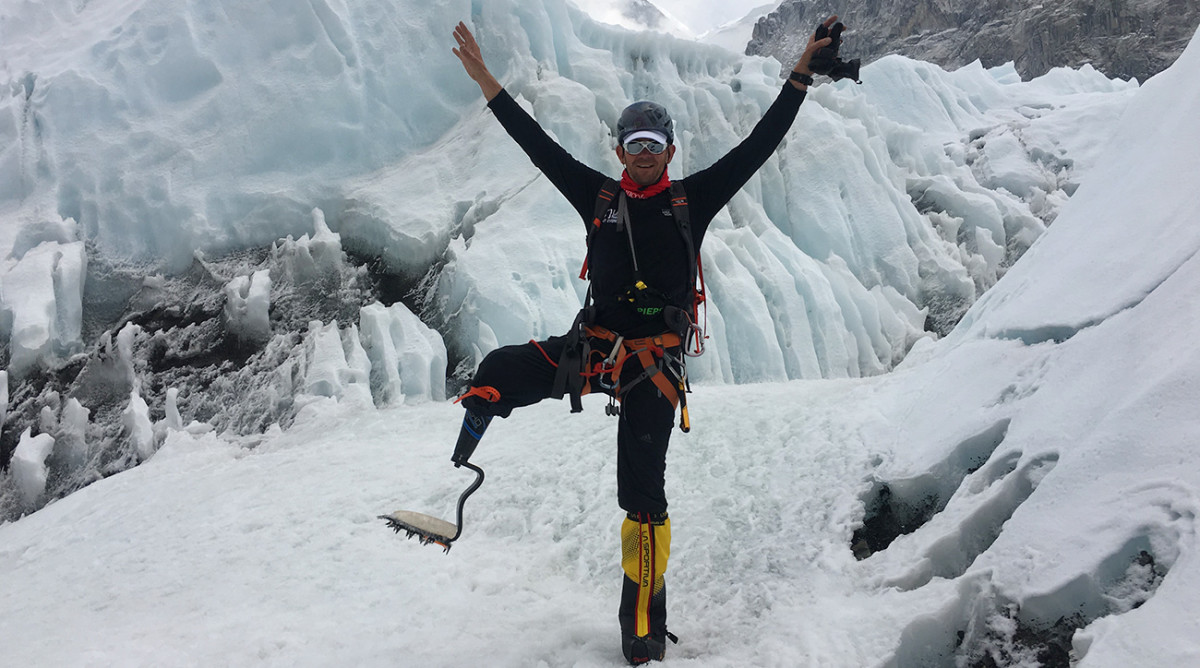
Although Jeff Sr. was not around to see his son attempt Everest, he did live to see him flip the hard-luck script of his early life, using his wheelchair and various prosthetic legs to (figuratively) to batter down doors. He watched Jeff Jr. win national championships for his country, finish Ironmans and deliver motivational speeches in which he described that terrifying day on the farm as a blessing and a catalyst.
For all his athletic success, Jenelle believes her brother’s “true gift in life” is fatherhood. Jeff and Elizabeth have two children, Grace, 11, and Gavin, 9. Grace has an exceedingly rare genetic disorder called Mosaic Tetrosomy 5p, which causes her to have seizures—dozens every day. Putting into practice the lesson imparted by the strong woman from the hospital when Jeff was eight years old, he and Elizabeth are compassionate and loving with Grace, but they also “hold her accountable,” says Jenelle. “They don’t cut her any slack.”
“I’m very inspired by the craziness,” Jenelle says—referring to her brother’s adventures—“but I’m more proud of the way he interacts with Grace, always encouraging her, always with a smile on his face.”
In 2015, Jeff and Grace attended an event hosted by Paradox Sports, a Boulder, Colo.–based organization that leads rock-climbing adventures for people with physical disabilities. Grace thrived: “For two hours on the wall, she had no seizures,” recalls Glasbrenner, who also had a blast.
Afterward, he was approached by the group’s leader, Sarah Leone, who told Glasbrenner that a Paradox team had been training for nearly a year to climb Grand Teton in Wyoming. But one of their athletes had recently broken his leg. Having watched Glasbrenner on the wall, Leone believed the group could get him up that mountain. Would he care to join the expedition?
He’d done no mountaineering, and that climb featured a number of fairly technical pitches not recommended for beginners. Count me in, he said. Standing at the summit a few weeks later, he realized that he’d found his newest happy place.
"I think you can do it,” Galvano told him. “I think Everest should be your next mountain.”
Two months later he was in Ecuador to scale Aconcagua, at 22,838 feet the highest point in the Western Hemisphere. How steep was his learning curve? “Well, for one thing,” he says, “I’d never slept in a tent before.”
The only male in his five-person group, Glasbrenner jokingly asked their guide, Mariano Galvano, “Who are you more worried about—the four women or the amputee?”
“I’m more worried about you,” was Galvano’s reply.
Not for long. Glasbrenner had no problems with the altitude and summited without incident. He and Galvano became good friends. They talked constantly about Everest. “I think you can do it,” Galvano told him. “I think it should be your next mountain.”
Glasbrenner agreed. Fortunately for him, so did his sponsor, Lincoln Financial, which footed the $100,000 bill for an Everest expedition. A Step Ahead, the company that designs Glasbrenner’s prosthetics, got busy on a purpose-built “Everest leg.”
On March 31, 2016, he flew to Kathmandu to meet his new teammates.
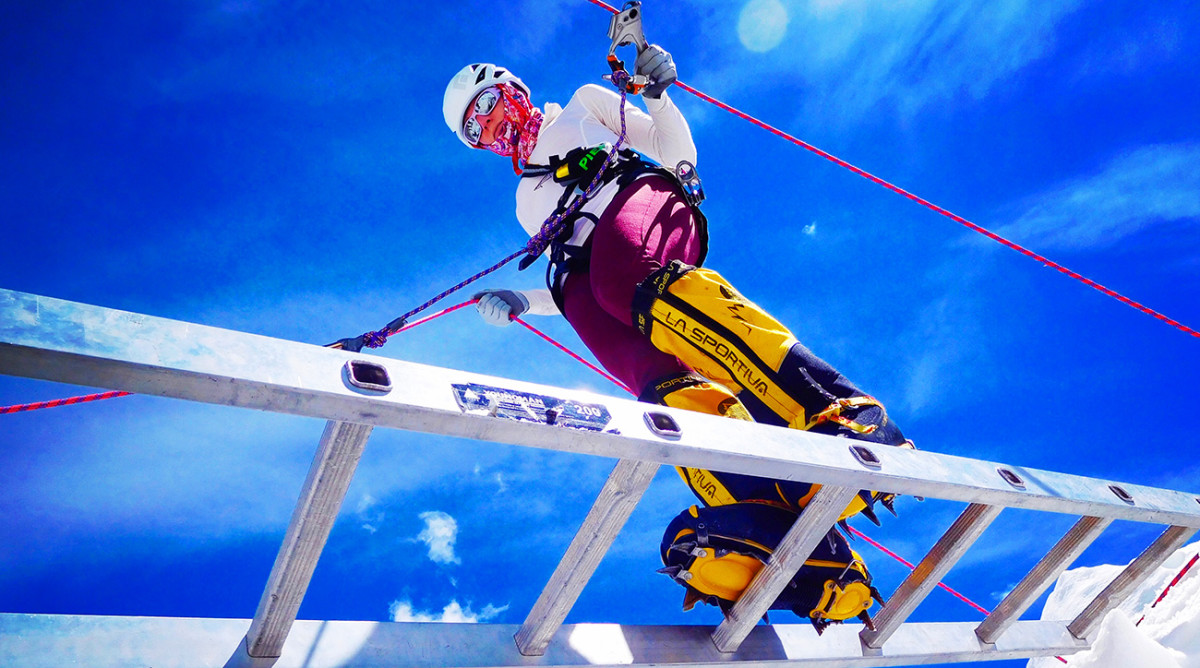
Asked how she first got into mountain climbing, Lisa Thompson smiles. “To be honest,” she admits, “what got me into it was spite.”
When she worked at Hewlett-Packard, Thompson was promoted to a middle-management position, and all her counterparts were male. Those guys and their bosses, all vice presidents, would go on monthly excursions in the mountains. Thompson was never invited. Rather than ask to be included, she says, “I just said, O.K., I’ll climb my own mountain.
“After a few peaks, I realized this wasn’t just a weekend pastime. It had worked its way into my identity. I found that I needed it, as a way to grow, to prove myself, to become more confident.” While she got challenges from her career, “I found out more about myself in the mountains. Because the stakes are so much higher.”
She and Glasbrenner got on famously: “Jeff and I bonded because people doubted us. They looked at him, saw his leg, and thought, ‘He’ll get up to Camp 2 and tap out.’ They didn’t know that he is the most competitive person I’ve ever met.”
In the documentary, Glasbrenner is sitting in a tent at Camp 2, talking about their day’s work: a trek up the Lhotse Face to Camp 3, then back. “Jeff was out the back, as usual,” says Nick Perks, another teammate. “I was stopping to look after him.” Both men are smiling because the opposite was true: Glasbrenner was a beast; he arrived at Camp 2 a half hour before the others.
They spent five increasingly miserable days at Camp 2, waiting for a window of decent weather. When the decision was made to push for the summit, “It was kind of a s--- show,” says Thompson. People packed quickly and started climbing.
The ascent from Camp 3 to Camp 4 was made in blizzard conditions, and it took longer than expected. They arrived mid-afternoon, spent. Rather than go for the summit that night, they took an extra day to “rest,” to the extent such a thing is possible at 26,000 feet.
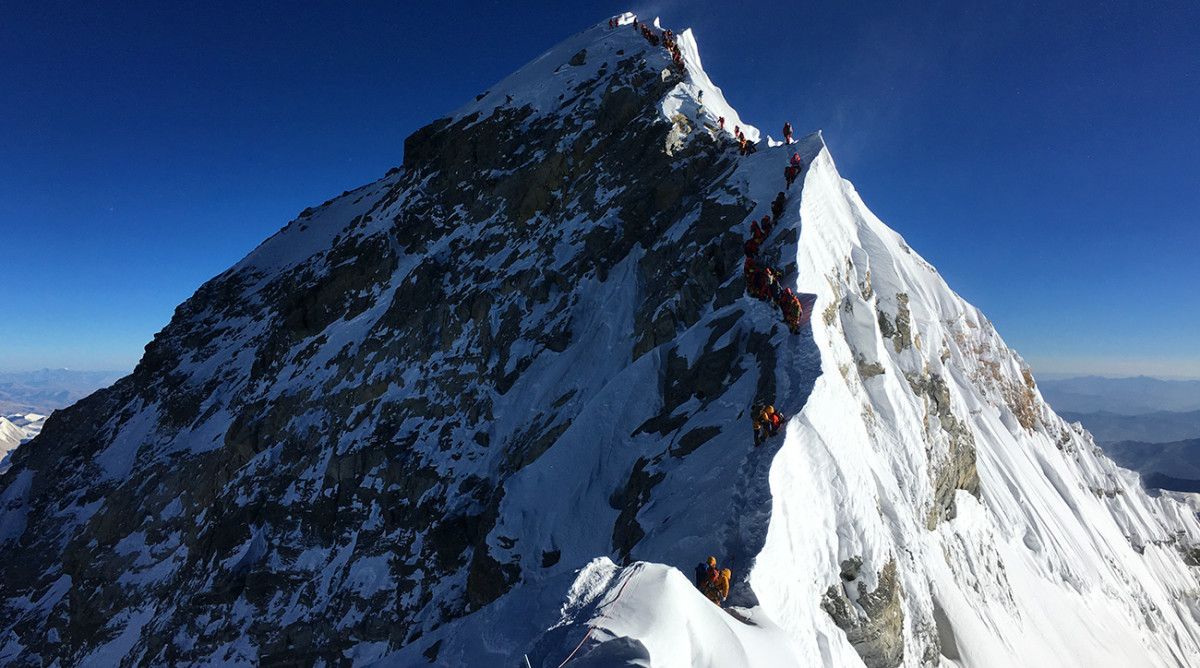
In the end, it was the right call. The weather on their summit day was beautiful. The heavy snow that had socked them in below was, in its way, a mitzvah: It spared them the sight of the many well-preserved corpses serving as unwelcome guideposts and markers in the death zone.
On a clear day at sea level, says Glasbrenner, “you can see for 12 miles.” From the top of Everest that morning, he could see into India, Tibet and Nepal. He could see things his doctors could not.
To watch the full experience and explore more exclusive virtual reality content download the LIFE VR app for iOS and Android or visit si.com/capturing-everest.
